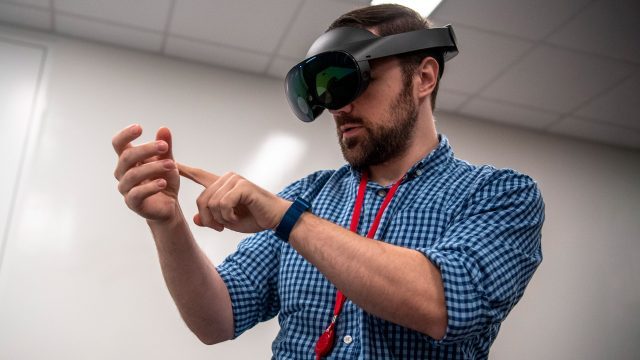Weight
Quest Pro is clearly the heavier device at 722g to Quest 2’s 503g. However, Quest 2’s 503g is with the default soft strap which is, in my opinion, terrible. So for me and anyone else who is adding a better strap to Quest 2, the weight jumps up much closer to what we see on Quest Pro. For instance, Quest 2 with the Elite Strap is 625g, or even more if you’re adding an extra battery on top of that.
So assuming you’ve got a decent strap on Quest 2, Quest Pro isn’t actually that much heavier. And the fact that it’s more compact means the momentum about your head will be somewhat reduced. In theory this has the potential to make Quest Pro the more comfortable headset, but that will likely come down to whether or not you like ‘halo’ style headstraps which is what Quest Pro employs.
Battery Life
This one is a doozy. At 2–3 hours of battery life, Quest 2 was already low enough to prompt a massive aftermarket of straps with additional batteries built-in (Meta even makes their own battery strap!). Quest Pro, with 1–2 hours of battery life seems like it’s going to be a real dealbreaker for some use-cases of the headset.
Meta was smart enough to try to address this problem with an included dock which will hopefully encourage people to keep the headset in an always-charged state—so at least it will be ready to go from one session to the next.
But it’s almost certain that many will be craving more runtime from Quest Pro. With a battery already in the back of the strap, it’s likely that batteries tethered to belts will become a popular accessory for the headset.
Controller Tracking

This one ought to be a straight-up win for Quest Pro (assuming tracking performance hasn’t been compromised). With on-board inside-out tracking and new features, the Touch Pro controllers are just better in every way.
Gone is the tracking ring which gives the controllers a tighter center of gravity and makes them much less likely to bump together.
On-board inside-out tracking means the controllers can track anywhere, even when your hands are at your side, behind you, or even if they are occluding each other.
Then there’s improved haptics, a new pinch sensor, and a new stylus sensor, opening new ways to use the controllers (I talk more about how each of these work here).
Luckily though, this is a win-win for both Quest Pro and Quest 2, since the controllers are compatible with both! They aren’t cheap, but if you like what you see, you’ll be able to add Touch Pro controllers and their new capabilities to Quest 2 for $300.
Expression Tracking

This is of course another big win for Quest Pro. The headset has five inward-facing sensors that watch your eyes and face, allowing the headset to create a pretty compelling model of your expressions. Even in these early stages it’s making a big difference to the feeling of avatars in social VR settings.
Eye-tracking can also be used for much more than making you look more natural in social settings, even beyond what I mentioned further above (how eye-tracking allows Quest Pro to tell users where the ideal lens position is for their specific eyes).
For one, eye-tracking can be used for input, giving developers additional insight into what you intend to do so that a game can feel more intuitive (or in the case of something like a horror game, even more scary!).
Beyond that Quest Pro supports dynamic foveated rendering which uses eye-tracking to render a high resolution portion of the scene only where you’re looking. This allows the world to appear more detailed without an increase in processing power.
Meta tells me a foveated rendering solution will be provided to developers, but they’ll also be allowed to implement their own.
Audio
Like Quest 2, Quest Pro uses on-board audio built into the headstrap. It’s still not going to come close to satisfying audiophiles or gamers looking for maximum immersion, but Meta claims it has made some improvements to the speakers that “in most cases can deliver over a half octave deeper bass tones” on Quest Pro. It also says it has reduced the outbound sound of the headset by 10dB compared to Quest 2, making sounds quieter for those outside the headset.
Passthrough View

Both Quest Pro and Quest 2 have a passthrough view and passthrough AR capabilities, but Quest Pro offers the clearly superior experience. Not only does Quest Pro gain full-color passthrough, the view is higher resolution too.
Meta has confirmed with Road to VR that Quest Pro’s front-facing sensors are 1,280 × 1,024, compared to the 648 × 488 sensors on Quest 2. That makes for a substantially clearer view of the real world on Quest Pro. Granted, there’s still a lot of improvement here… we’re pretty far from being able to read normal sized font using the passthrough view.
Increased sensor resolution doesn’t just mean the passthrough video looks better, it also means Quest Pro likely creates a more accurate depth estimate of the world around you which informs how accurate the stereoscopic reconstruction is which makes depth more realistic, especially at the edges of objects. This means the headset’s understanding of the geometry of the world around you is a little less coarse, making passthrough AR look and feel a little more realistic.
Ultimately Quest Pro feels like a single headset that offers a high quality AR or VR experience, which is why it’s the first headset from Meta that we’re calling mixed reality.
Well that’s some 2,000 words on the differences between Quest Pro and Quest 2. You couldn’t possibly have more questions, could you? Just kidding, I’m sure you do—feel free to fire away in the comments below!






